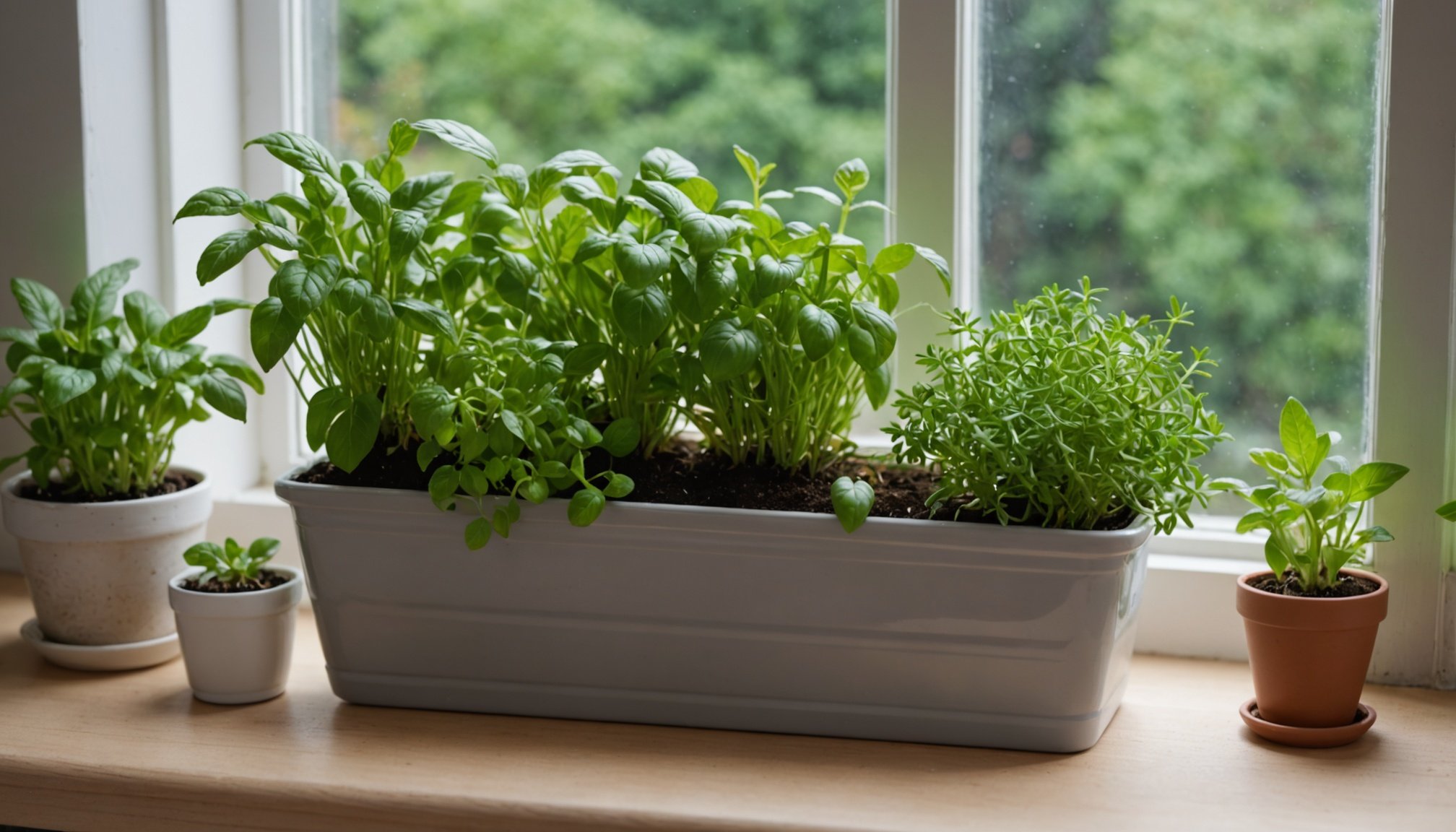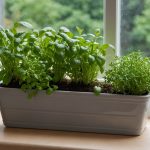Window Sill Wonders: Your Ultimate Guide to Growing a Thriving Herb Garden in Miniature Greens
Growing an herb garden on your windowsill is a great way to bring a touch of nature and freshness into your home, even in the smallest of spaces. Here’s a comprehensive guide to help you get started and ensure your herbs thrive.
Choosing the Right Herbs for Your Indoor Garden
When it comes to selecting herbs for your indoor garden, it’s essential to pick varieties that are well-suited for indoor conditions and can thrive in limited space.
Also to see : Essential innovative features to look for in your next smart refrigerator
Popular Herbs for Indoor Gardening
Here are some of the best herbs to grow indoors:
- Basil: A classic choice, basil loves warm temperatures and plenty of sunlight. It’s easy to grow and can be harvested in as little as 6-8 weeks.
- Mint: Mint is hardy and can grow in partial shade, making it perfect for windowsills that don’t get direct sunlight all day.
- Chives: Chives are low maintenance and require minimal care. They can tolerate some shade and are ready to harvest in about 8-10 weeks.
- Parsley: Parsley prefers partial shade and consistent moisture. It’s a slow grower but adds a fresh flavor to many dishes.
- Thyme: Thyme is another low-maintenance herb that can thrive in indoor conditions. It prefers well-drained soil and partial shade.
Preparing the Perfect Soil for Your Herbs
The soil you use can make a significant difference in the health and growth of your herbs.
Also read : Discover the best heat-resistant countertop materials for hot pots and pans: your comprehensive guide
Key Components of Herb Garden Soil
Here are the key components to include in your herb garden soil:
- Well-Drained Soil: Herbs hate wet feet, so ensuring your soil drains well is crucial. A mix of potting soil, perlite, and sand can help achieve this[1][2][3].
- Organic Matter: Adding compost or peat moss can enhance soil fertility and structure.
- pH Balance: Most herbs prefer a slightly acidic to neutral soil pH, ranging from 6.0 to 7.0.
DIY Herb Garden Soil Mix
Here’s a simple recipe to create your own herb garden soil mix:
| Component | Percentage |
|---|---|
| Potting Soil | 50% |
| Perlite | 20% |
| Sand | 10% |
| Compost | 10% |
| Peat Moss | 10% |
Mix these ingredients well to ensure a balanced and well-drained soil.
Providing the Right Conditions for Growth
Herbs need specific conditions to grow well indoors.
Sunlight and Temperature
- Sunlight: Most herbs need at least 4-6 hours of direct sunlight per day. If your windowsill doesn’t get this much sunlight, consider using grow lights to supplement the natural light[1][3].
- Temperature: Herbs generally prefer daytime temperatures between 65-75°F (18-24°C) and nighttime temperatures around 55-65°F (13-18°C).
Watering Your Herbs
Proper watering is critical to prevent root rot and ensure healthy growth.
- Watering Frequency: Water your herbs when the top inch of soil feels dry to the touch. Avoid overwatering, as this can lead to root rot.
- Humidity: Some herbs, like mint and basil, prefer a humid environment. You can increase humidity around your plants by placing the pot on a tray filled with water and pebbles[2].
Planting and Maintaining Your Herb Garden
Planting and maintaining your herb garden involves several steps to ensure your herbs grow and thrive.
Planting Seeds or Seedlings
- Seeds: Plant seeds about 1/8 inch deep and 1-2 inches apart. Cover the seeds with a thin layer of soil and water gently.
- Seedlings: If using seedlings, space them about 2-3 inches apart to allow for proper growth.
Pruning and Harvesting
- Pruning: Regular pruning helps keep your herbs bushy and encourages new growth. Pinch off flower buds to direct the plant’s energy towards leaf growth.
- Harvesting: Harvest your herbs regularly to promote continuous growth. For leafy herbs like basil and parsley, pinch off individual leaves or stems as needed.
Common Challenges and Solutions
Even with the best care, you might encounter some challenges.
Root Rot
- Causes: Overwatering is the most common cause of root rot.
- Solution: Check the roots for rot and trim off any affected areas. Repot the herb in fresh, well-drained soil.
Pests
- Causes: Indoor pests like spider mites, mealybugs, and aphids can infest your herbs.
- Solution: Use neem oil or insecticidal soap to treat infestations. Isolate the affected plant to prevent the pests from spreading.
Tips for Growing Microgreens
Microgreens are young, nutrient-dense versions of your favorite herbs and can be grown on your windowsill.
Why Grow Microgreens?
- Nutritional Value: Microgreens are packed with vitamins and minerals, often more so than their mature counterparts.
- Ease of Growth: Microgreens are easy to grow and can be harvested in as little as 7-10 days.
How to Grow Microgreens
Here’s a step-by-step guide to growing microgreens:
- Choose Your Seeds: Select high-quality seeds specifically labeled as “microgreen” or “sprouting” seeds.
- Prepare the Soil: Use a well-drained potting mix.
- Sow the Seeds: Sow the seeds densely on the surface of the soil. Cover with a thin layer of soil.
- Water and Maintain: Keep the soil consistently moist but not waterlogged. Provide indirect sunlight.
- Harvest: Harvest your microgreens when they have 1-3 sets of leaves, usually within 7-10 days.
Growing an herb garden on your windowsill is a rewarding and easy way to bring fresh flavors and aromas into your home. By choosing the right herbs, preparing the perfect soil, providing the right conditions, and maintaining your garden, you can enjoy a thriving and productive herb garden all year round.
Additional Resources
For more detailed information and specific care tips, here are some additional resources:
- Books: “The New Seed Starter’s Handbook” by Nancy Bubel and “The Herb Book” by John B. Lust.
- Online Forums: Join online gardening forums or social media groups to connect with other gardeners and get tips specific to your region.
- Amazon: Check out Amazon for a variety of herb seeds, soil mixes, and gardening tools tailored to indoor gardening.
By following these guidelines and tips, you’ll be well on your way to creating a vibrant and thriving herb garden right on your windowsill. Happy gardening











